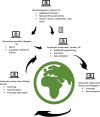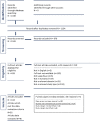A rapid research needs appraisal methodology to identify evidence gaps to inform clinical research priorities in response to outbreaks-results from the Lassa fever pilot
- PMID: 31185979
- PMCID: PMC6560772
- DOI: 10.1186/s12916-019-1338-1
A rapid research needs appraisal methodology to identify evidence gaps to inform clinical research priorities in response to outbreaks-results from the Lassa fever pilot
Abstract
Background: Infectious disease epidemics are a constant threat, and while we can strengthen preparedness in advance, inevitably, we will sometimes be caught unaware by novel outbreaks. To address the challenge of rapidly identifying clinical research priorities in those circumstances, we developed and piloted a protocol for carrying out a systematic, rapid research needs appraisal (RRNA) of existing evidence within 5 days in response to outbreaks globally, with the aim to inform clinical research prioritization.
Methods: The protocol was derived from rapid review methodologies and optimized through effective use of pre-defined templates and global time zones. It was piloted using a Lassa fever (LF) outbreak scenario. Databases were searched from 1969 to July 2017. Systematic reviewers based in Canada, the UK, and the Philippines screened and extracted data using a systematic review software. The pilot was evaluated through internal analysis and by comparing the research priorities identified from the data, with those identified by an external LF expert panel.
Results: The RRNA pilot was completed within 5 days. To accommodate the high number of articles identified, data extraction was prioritized by study design and year, and the clinical research prioritization done post-day 5. Of 118 potentially eligible articles, 52 met the data extraction criteria, of which 46 were extracted within the 5-day time frame. The RRNA team identified 19 clinical research priorities; the expert panel independently identified 21, of which 11 priorities overlapped. Each method identified a unique set of priorities, showing that combining both methods for clinical research prioritization is more robust than using either method alone.
Conclusions: This pilot study shows that it is feasible to carry out a systematic RRNA within 5 days in response to a (re-) emerging outbreak to identify gaps in existing evidence, as long as sufficient resources are identified, and reviewers are experienced and trained in advance. Use of an online systematic review software and global time zones effectively optimized resources. Another 3 to 5 days are recommended for review of the extracted data and to formulate clinical research priorities. The RRNA can be used for a "Disease X" scenario and should optimally be combined with an expert panel to ensure breadth and depth of coverage of clinical research priorities.
Keywords: Clinical research priorities; Emerging infectious diseases; Lassa fever; Outbreak response; Rapid research needs appraisal methodology.
Conflict of interest statement
All authors declare that they have no competing interests.
Figures
Similar articles
-
Folic acid supplementation and malaria susceptibility and severity among people taking antifolate antimalarial drugs in endemic areas.Cochrane Database Syst Rev. 2022 Feb 1;2(2022):CD014217. doi: 10.1002/14651858.CD014217. Cochrane Database Syst Rev. 2022. PMID: 36321557 Free PMC article.
-
Research as a pillar of Lassa fever emergency response: lessons from Nigeria.Pan Afr Med J. 2020 Oct 27;37:179. doi: 10.11604/pamj.2020.37.179.26425. eCollection 2020. Pan Afr Med J. 2020. PMID: 33447334 Free PMC article.
-
Addressing challenges for clinical research responses to emerging epidemics and pandemics: a scoping review.BMC Med. 2020 Jun 25;18(1):190. doi: 10.1186/s12916-020-01624-8. BMC Med. 2020. PMID: 32586391 Free PMC article.
-
Beyond the black stump: rapid reviews of health research issues affecting regional, rural and remote Australia.Med J Aust. 2020 Dec;213 Suppl 11:S3-S32.e1. doi: 10.5694/mja2.50881. Med J Aust. 2020. PMID: 33314144
-
Re-emerging Lassa fever outbreaks in Nigeria: Re-enforcing "One Health" community surveillance and emergency response practice.Infect Dis Poverty. 2018 Apr 28;7(1):37. doi: 10.1186/s40249-018-0421-8. Infect Dis Poverty. 2018. PMID: 29703243 Free PMC article.
Cited by
-
Systematic review and meta-analysis of the epidemiology of Lassa virus in humans, rodents and other mammals in sub-Saharan Africa.PLoS Negl Trop Dis. 2020 Aug 26;14(8):e0008589. doi: 10.1371/journal.pntd.0008589. eCollection 2020 Aug. PLoS Negl Trop Dis. 2020. PMID: 32845889 Free PMC article.
-
Methodological challenges of analysing COVID-19 data during the pandemic.BMC Med Res Methodol. 2020 Apr 14;20(1):81. doi: 10.1186/s12874-020-00972-6. BMC Med Res Methodol. 2020. PMID: 32290816 Free PMC article. No abstract available.
-
PEARLES challenges and solutions to the implementation of clinical research responses to epidemics and pandemics: a scoping review.EClinicalMedicine. 2025 Jun 27;85:103294. doi: 10.1016/j.eclinm.2025.103294. eCollection 2025 Jul. EClinicalMedicine. 2025. PMID: 40678698 Free PMC article. Review.
-
A scoping review on research agendas to enhance prevention of epidemics and pandemics in Africa.Pan Afr Med J. 2020 Nov 24;37(Suppl 1):40. doi: 10.11604/pamj.supp.2020.37.40.23458. eCollection 2020. Pan Afr Med J. 2020. PMID: 33456664 Free PMC article.
-
Research prioritisation in preparedness for and response to outbreaks of high-consequence pathogens: a scoping review.BMC Med. 2025 Mar 10;23(1):147. doi: 10.1186/s12916-025-03973-8. BMC Med. 2025. PMID: 40059172 Free PMC article.
References
Publication types
MeSH terms
Grants and funding
LinkOut - more resources
Full Text Sources
Miscellaneous




